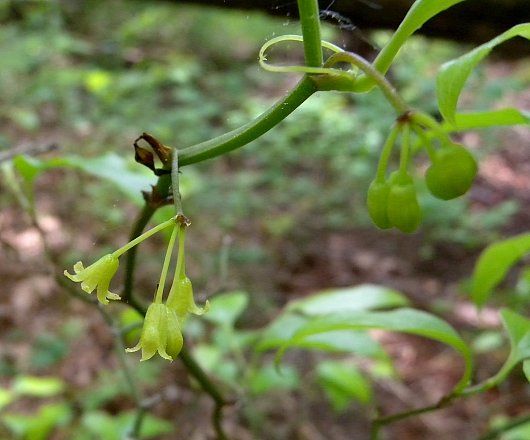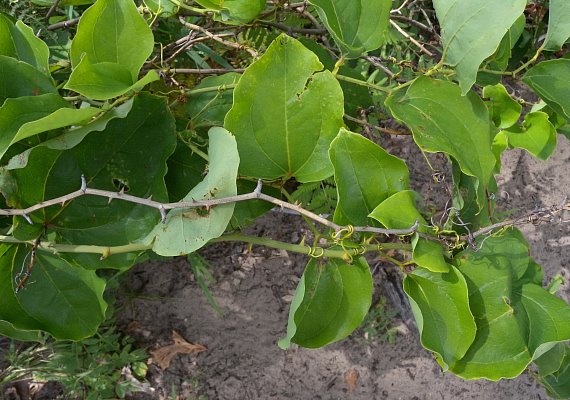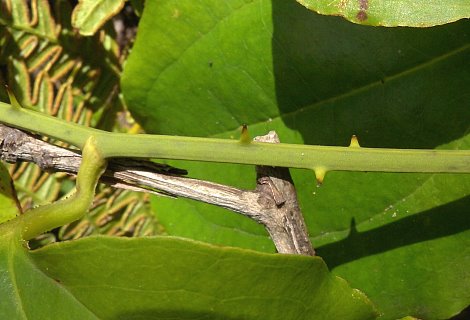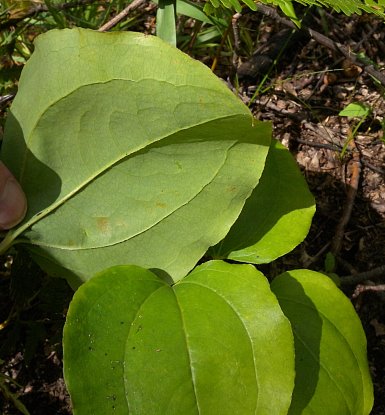
Umbels of 3-20 flowers (about ½-2" across) are produced from the axils of leaves. Because Round-Leaved Greenbrier is dioecious, male (staminate) and female (pistillate) flowers are produced on different vines. Both male and female flowers are about ¼" long, each flower consisting of 6 yellowish green or green tepals that are joined together at the base. Male flowers have 6 stamens with white anthers, while female flowers have a greenish pistil with 3 short stigmata. The peduncle of each umbel is ½-¾" long, pale green, and glabrous. The blooming period occurs from late spring to early summer for about 2 weeks. Afterwards, fertile female flowers are replaced by berries that become blue-black with a whitish bloom at maturity (late summer or fall). There berries are about ¼" across and globoid in shape; each fleshy berry contains 1-3 seeds. The root system is shallow, fleshy, and fibrous.

Cultivation: The preference is partial sun, moist to dry-mesic conditions, and a slightly acidic soil containing loam, clay-loam, rocky material, or sand. The seeds can remain dormant in the ground for several years; germination in the soil is enhanced by greater exposure to light.
Range & Habitat: The native Round-Leaved Greenbrier is fairly common in southern Illinois, while in the central and northern sections of the state it is absent (see Distribution Map). Illinois lies along the NW range limit of this species. However, it occurs in sandy areas along southern Lake Michigan in both Indiana and Michigan. Habitats include bottomland woodlands, sandstone bluffs, bluffs along rivers, sandy wooded slopes, sandy savannas, Red Maple swamps, stabilized sand dunes along Lake Michigan, woodland borders, powerline clearances in wooded areas, and thickets. Round-Leaved Greenbrier is a pioneer species that favors hilly disturbed areas where the soil is often sandy or rocky. This woody vine is able to resprout from its root system in response to occasional wildfires.

Faunal Associations: The insect visitors of the flowers for Round-leaved Greenbrier are probably similar to the flower visitors of Bristly Greenbrier (Smilax hispida), as they have very similar flowers. These visitors are likely small bees and flies seeking nectar and/or pollen, such as cuckoo bees (Nomada spp.), Halictid bees (Lasioglossum spp., Sphecodes spp.), Andrenid bees (Andrena spp.), flower flies (Syrphidae), blow flies (Calliphoridae), flesh flies (Sarcophagidae), and lance flies (Lonchaeidae). Miscellaneous wasps may visit the flowers as well (Robertson, 1929; Graenicher, 1902). Other insects feed destructively on foliage, plant juices, and other parts of Round-leaved Greenbrier and other greenbrier or carrion flower vines (Smilax spp.). This group of insects includes a leaf beetle (Pachyonychus paradoxus), larvae of the Smilax Leaf Midge (Dasineura smilacifolia), Woolly Maple Aphid (Neoprociphilus aceris), larvae of the Smilax Stem Gall Wasp (Diastrophus smilacis), larvae of a false diamondback moth (Acrolepiosis heppneri), larvae of the Smilax Leafminer Moth (Marmara smilacisella), larvae of other moths, and thrips (see the Insect Table for more information). The fruits of these vines are a source of food for many bird species. They include such species as the Cedar Waxwing, Northern Cardinal, Fox Sparrow, White-throated Sparrow, Ruffed Grouse, Wild Turkey, Greater Prairie Chicken, Eastern Bluebird, American Robin, and Swainson's Thrush (see Bird Table for more information). Mammals that eat the fruits of these vines include the Virginia Opossum, Raccoon, Fox Squirrel, and American Black Bear. The White-tailed Deer browses on the leaves and stems, while the Cottontail Rabbit gnaws on the woody branches of greenbriers during the winter (Martin et al., 1951/1961; Sotala & Kirkpatrick, 1973; Haugen, 1942). These vines provide protective cover for many kinds of wildlife and nesting habitat for some species of birds.

Photographic Location: A wooded sand dune near Lake Michigan at the Indiana Dunes State Park in NW Indiana.
Comments: Round-Leaved Greenbrier is one of several woody Smilax spp. that can be found in southern Illinois. In the rest of the state, only Bristly Greenbrier (Smilax hispida) has been found. Round-Leaved Greenbrier can be distinguished from the latter species by the absence of bristly thorns on its lower stems, the shorter peduncles of its umbels, and the presence of fewer primary veins (typically 3, less often 5) on its leaves. Other woody Smilax spp. in southern Illinois have leaves with swollen basal lobes, some pubescence on the leaf undersides, or glaucous leaf undersides that are noticeably whitened. Other common names of Smilax rotundifolia are Common Greenbrier and Round-Leaved Catbrier.